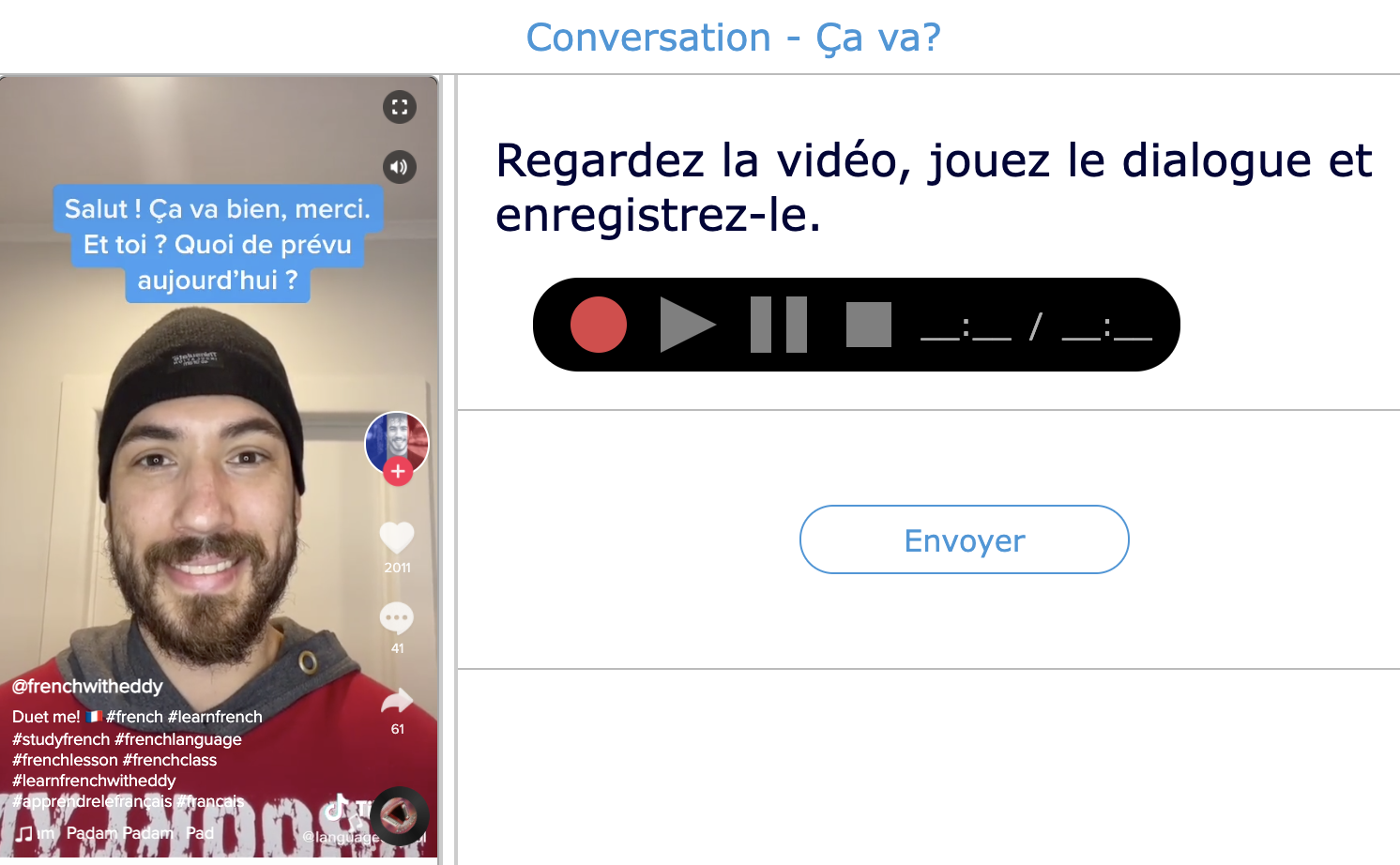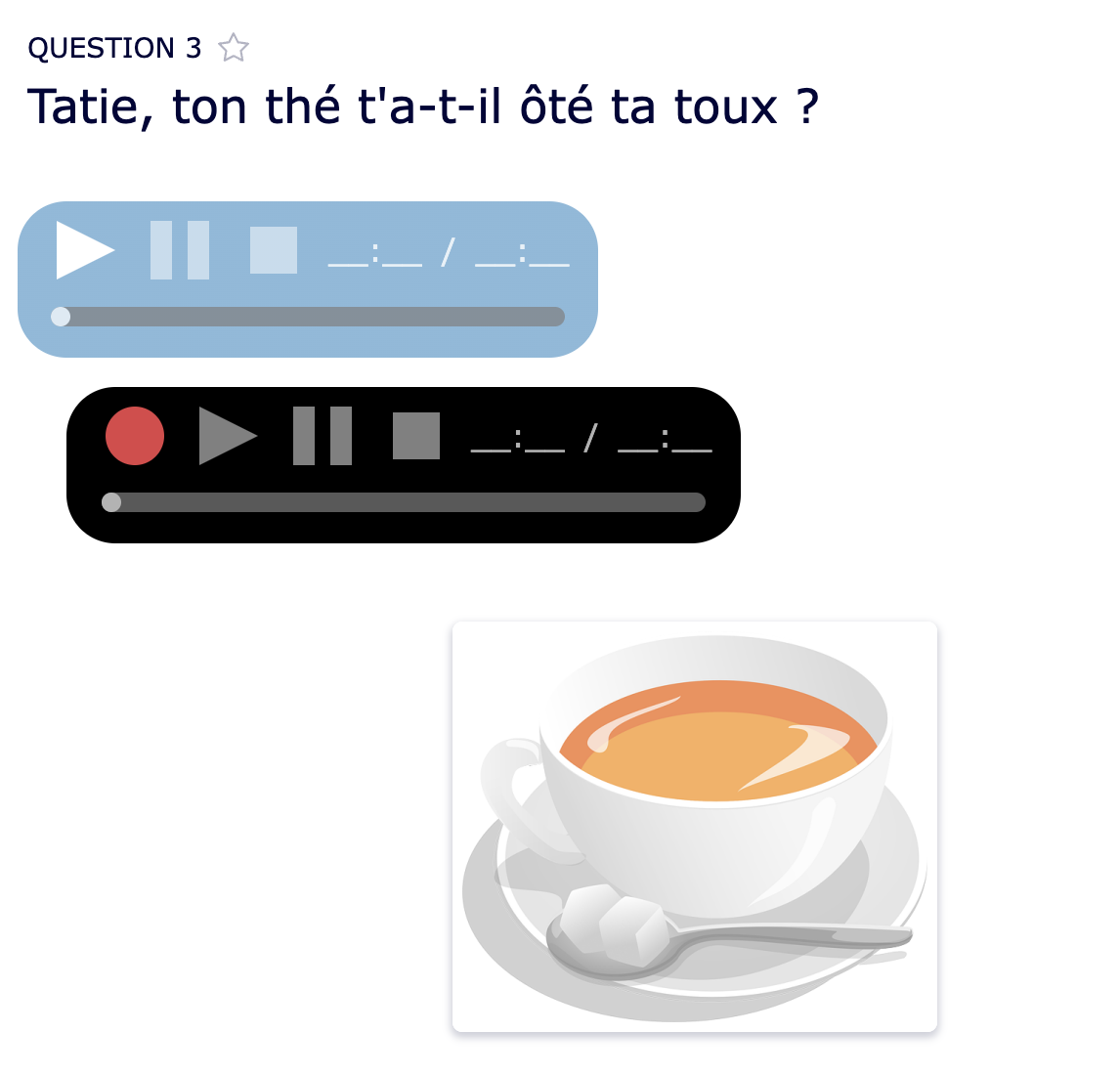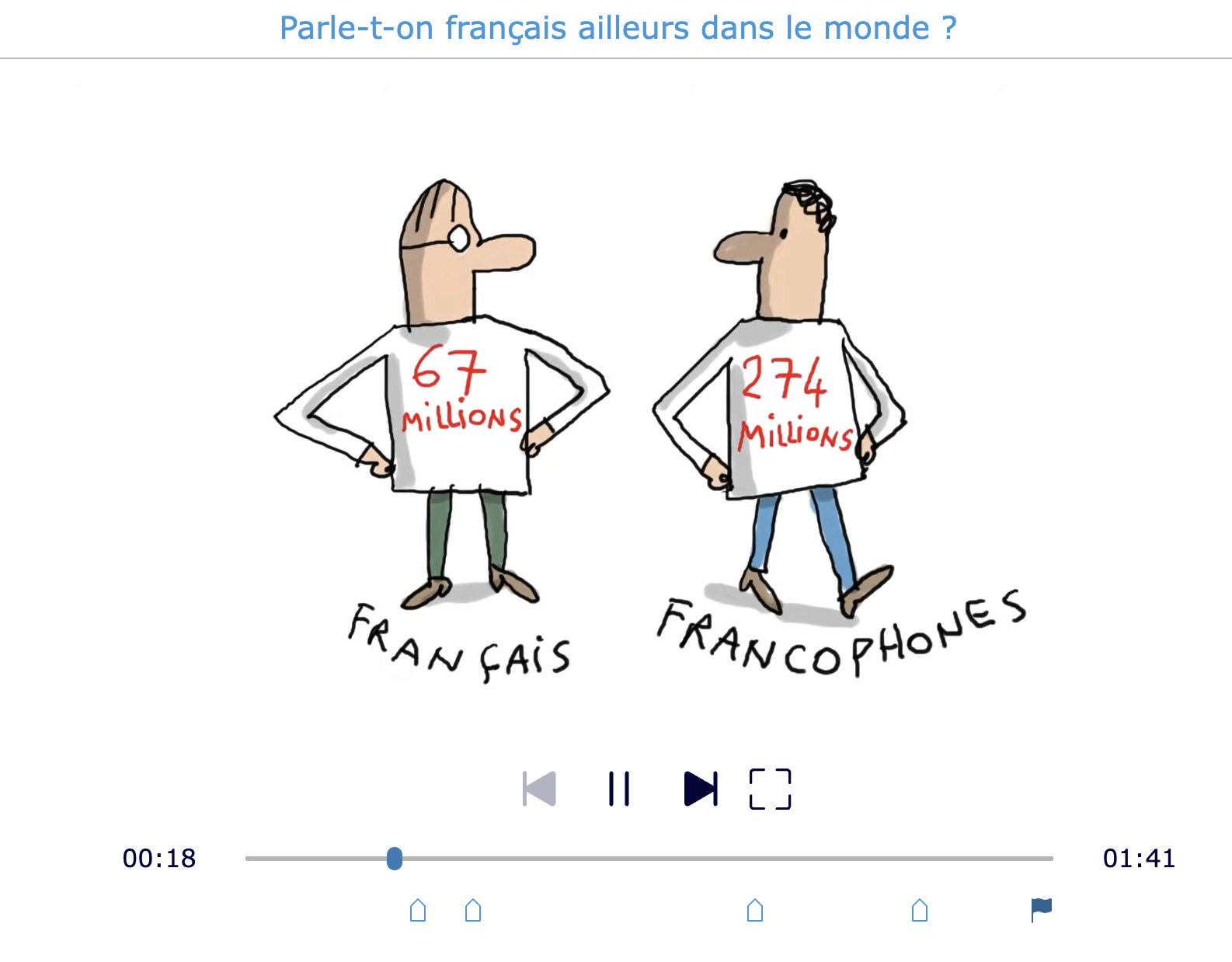30+ Ready-to-Use French Lesson Ideas to Boost Classroom Engagement
 Dimitri Bongers —
Dimitri Bongers —
Bonjour, les amis! Looking to spice up your French lessons and keep your students saying “C’est magnifique!”? You’re in the right place! In this post, we’ve rounded up 30+ ready-to-use French lesson ideas to boost engagement and make learning French a total joie. From interactive vocabulary activities to surprising grammar games, these fun and easy-to-implement ideas will save you time and make your classroom more dynamic. C’est parti!
All the digital French lesson activities in this blog post are free to use and created with BookWidgets. You can find these ready-to-use French lesson plans in this group. You can create a free BookWidgets account (if you don’t have one already) and copy the widgets to your account, allowing you to make some changes where necessary and receive your students’ answers in your account.
The online French exercises are divided into several categories that at the same time form the sections of this blog post:
- Exercises for French Speaking skills
- Exercises for French Listening skills
- Exercises for French Reading skills
- Exercises for French Writing skills
- Exercises for French Vocabulary
- Exercises for French Grammar
- Advanced French exercises
For some additional ressources, like a webinar about using BookWidgets for French lessons and public groups where FLE teachers share ready-made classroom activities, don’t forget to check the last section of this blog post:

Exercises for French Speaking skills
Digital tools may not spontaneously come to mind when developing speaking skills. Yet BookWidgets offers many features, such as widgets that can serve as source files for a speaking exercise or presentation, tools to practice the pronunciation of new vocabulary, and the audio recording question type. Discover all the possibilities in the examples below.
1. Practice French conversations (with TikTok video and audio recording question)
Conversations are an important skill for language learners, but beginners often lack confidence to practice this right away with classmates or the teacher. TikTok offers an interesting solution to this, with dedicated language-learning accounts that publish videos in which the idea is to have a conversation by using the Duet function. If you like this idea, but you don’t want your students to post the result on TikTok because of privacy concerns, you could do this kind of activity within a split worksheet in BookWidgets, like in the example below.
💡 For more TikTok lesson ideas, check out our previous blog post.
2. Use Flash Cards with audio to learn the pronuncitation of new words
When teaching vocabulary, it is important that students also master the pronunciation of the new words. This is perfectly possible with these Flash Cards, which allow you to easily add audio clips. You can choose to record the audio yourself, upload existing audio files, or use the standard text-to-speech method.
3. Tell a story with random elements
Use the randomness widget to have students tell a story that should include three randomly chosen elements. You control how much preparation time they get for this assignment.
4. Practice pronunciation with a Hangman game
Hangman (or Snowman) is not only a perfect tool for learning new vocabulary, but you also practice pronunciation. On the one hand, students learn to pronounce the words they need to find, but also of the letters of the alphabet. The way letters like E, G, H, W, X, and Y are pronounced in French differs from many other languages.
5. Learn the comparison with a Before & After widget
In this example, the interactive exercise is a resource that students use during a speaking exercise. In the Before & After widget, they see two pictures of the same square in Antwerp, Belgium. The square has changed a lot in 10 years. Students can explain these changes, practicing the comparative form and past tenses.
6. Present a short film character
The short film “Flatlife” depicts the lives of four neighbors in an apartment. Students observe and analyze one of the characters and then present it to their classmates. The assignment includes clear instructions for students, a rubrics evaluation grid, and a bonus assignment.
💡 This widget was created as part of an earlier blog post with ready-to-use short film lesson plans. Check out the other short film activities for language lessons in this folder.
7. Have fun with French tongue twisters
Tongue twisters, or virelangues, as they are called in French, are an excellent way to practice certain sounds in a playful way. The useful thing about this exercise is that students can listen to the correct pronunciation first, and then record their own attempt. As a teacher, you can listen to these and give them feedback.

Exercises for French Listening skills
Fortunately, for testing listening skills, you no longer need a cassette player with questionable audio quality. Nowadays, teachers can easily find a lot of beautiful, authentic audio documents online. With YouTube videos, podcasts, audiobooks, etc., and suitable tools to practice and test your students’ listening skills available, practicing and testing French listening skills is more engaging than ever before.
8. Watch a video from a French YouTuber
Cyprien is a well-known French YouTuber, and many of the themes covered in his videos are very relatable to young people worldwide. One of his most famous videos is about his school life, where he humorously talks about what annoyed him at school. This Split Worksheet allows students to answer questions while watching the video.
9. Listen to directions
A classic for anyone learning a foreign language: asking (and explaining) directions. With a Split Whiteboard, teachers can easily add audio instructions (you can record them or upload a file). Furthermore, you just need to add a background image in the Whiteboard section…et voilà. Students can annotate the map, and you, as a teacher, can see if they did well.
10. Explore a French podcast
Podcasts are more popular than ever, and of course there are plenty of French-language podcasts available for all levels of French learners. Below is an example of how a podcast can be used as a tool to practice or test French listening skills.
💡 For more podcast lesson ideas, check out our previous blog post.
11. Learn about the history of the French language in a Video Quiz
In this video quiz, students learn more about the number of French speakers in the world and how the French language has spread and is evolving today. The video is from 1 jour 1 question. We’ve made it interactive by adding questions that will automatically appear in the video.
12. Discover different French accents from around the world
This French exercise perfectly complements the previous one. French is spoken all over the world, so there are many interesting regional accents and variations. In this interactive hotspot image, students discover the sounds of variations from places such as Quebec, Switzerland, Belgium, Ivory Coast, Congo, and more.

Exercises for French Reading skills
In this section you will discover how to teach, practice and test reading skills in an interactive way. Whether reading classics of French literature, authentic documents or instructions, there are plenty of options.
13. Read a chapter from Le Petit Prince, a French classic
A Split Worksheet is perfect for developing or testing students’ Reading Comprehension skills. On the left, they see the text, and on the right, they see the questions (BookWidgets offers over 35 question types). Below is an example of such an activity based on the French classic “Le Petit Prince.”
14. Study authentic documents
In foreign language teaching, it is very valuable to work with authentic documents as much as possible. For students, learning feels more meaningful when working with real source files. Below is an example of a reading comprehension activity based on an insurance form students should analyze to answer the accompanying questions.
15. Draw out items based on the French instructions
Testing reading comprehension with questions is not always evident, as students may have understood the text but fail to formulate their answers. They would then score poorly for reading, whereas the problem is more likely to be with writing skills. A solution can be seen in the example below, where students are not required to write answers but only to draw out items following the French instructions.
16. Set up a Timeline based on a story
Summarizing a story is an important skill. You can make this task more interactive, e.g. with a timeline widget as shown in the example below. Students create their own timeline in which they place the key elements of the story with a title, description and possibly a picture.
17. Explore a city with Google Street View
When you can pique your students’ curiosity, they will enjoy reading a French text. The assignment below is part of an online Escape Game. Only when students properly read and execute the instructions (in Google Street View) will they be able to answer the question and get the password for the next step.

Exercises for French Writing skills
You can also use digital tools to practice writing skills. This does not replace writing with pen and paper; the two are complementary. The advantage of using BookWidgets for writing skills is that you can give students an on-screen keyboard (for typing accented French letters), activate a word count, and grade efficiently with correction labels.
18. Invent a WhatsApp conversation
The assignment below combines reading and writing skills. Students read a story and then have to invent a fictional WhatsApp conversation between two characters. Note that the on-screen keyboard is active here. The button on the top right makes it easier for students to type French letters with accents.
19. Write a YouTube comment
Today’s students are growing up with platforms like YouTube, so teaching them to write a YouTube comment is definitely a relevant exercise. In this assignment, students have to write a text of at least 50 words. Through the word count, students can check if they meet this requirement.
💡 This widget was created as part of an earlier blog post with ready-to-use short film lesson plans. Check out the other short film activities for language lessons in this folder.

Exercises for French Vocabulary
The opportunities for learning and practicing vocabulary are endless. This section explains how to activate new vocabulary with interactive tools such as Flash Cards, Crosswords, Memory, Hangman, and more.
20. Practice basic vocabulary with a Quiz or Worksheet
The Quiz and Worksheet widgets in BookWidgets have more than 35 question types, at least half of which can be used for practicing new vocabulary: multiple-choice questions, combination questions, drag-and-drop exercises, and more. As a teacher, you choose whether to receive students’ answers.
21. Study vocabulary with Flash Cards
Flash Cards are an ideal tool for students to practice vocabulary independently. In this digital version of Flash Cards, the teacher can add text, images, and audio.
22. Play a Pair Matching Game
In a pair-matching game, the idea is for students to find two cards that match. The content of the cards can be text, audio, or pictures. So, it is ideal for them to practice new vocabulary without providing translation. In the example below, students learn familiar proverbs that include animals.
23. Challenge students with a Memory Game
When the Pair-Matching game is too simple, you can challenge students with a Memory game. The principle is the same, but the cards are reversed. When you play this on an interactive blackboard, you can put letters, numbers, or emojis on the back of each card so students also practice these concepts.
24. Have fun with a Bingo Card
The concept of bingo is super simple but very efficient. Each student is given a bingo card where the cards (words or pictures) are in a random order. The teacher names words, and the student with a complete row first shouts, “Bingo.” While having fun, students learn the pronunciation of new words.
25. Test your students’ knowledge with a Hangman Game
Hangman is another playful way to practice new vocabulary. While most of BookWidgets’ other widgets let students work individually, hangman is usually played in class, with the exercise projected on a digital whiteboard. It’s ideal for group fun!
26. Listen to new words in a Hotspot Image
A hotspot image is a perfect tool for learning new vocabulary. When you add audio, as in the example below, students immediately learn the pronunciation of the new words. Moreover, they never need the source language.
27. Fill in a Crossword puzzle
Students love crossword puzzles! And there’s more good news: with BookWidgets, they are very easy to set up. In a crossword, students learn to pay attention to correct spelling because if they write one letter too many or too few, the word no longer fits.
28. Search the words in a Word Search activity
Word Search is another activity that students enjoy doing. Plus, in BookWidgets, you don’t always have to re-add all the content. In this example, I imported the words already used in the crossword above.

Exercises for French Grammar
Grammar doesn’t have to be boring! There are plenty of ways to make grammar interactive and engaging, with Quizzes, Flash Cards, Randomness widgets, and more. You’ll discover it in the examples below.
29. Practice basic grammar with a Quiz or Worksheet
The Quiz and Worksheet widgets in BookWidgets have more than 35 question types, at least half of which can be used for practicing grammar: multiple-choice questions, combination questions, drag-and-drop exercises, and more. As a teacher, you choose whether to receive students’ answers.
30. Listen to French music and find grammar in the lyrics
In French classes, music is often used inside to address culture or introduce vocabulary. However, grammar can also be taught or practiced using French music, as the example below shows.
31. Analyze grammatical tenses in a Timeline
A particularity of French grammar are conjugations and multiple tenses, items that many French learners have difficulty with. What is important here is that they keep track. A timeline widget, as in the example below, can help with this.
32. Study irregular forms with Flash Cards
The French verbs have many irregular forms and exceptions that students must memorize. Flash Cards can help with this. This example shows how they can rehearse irregular forms of the past participles.
33. Apply grammatical rules with a Randomness activity
To test whether students really master the grammar and are able to apply it in specific contexts, you can challenge them with a Randomness widget. In the example below, they have to create a correct sentence with the given elements (one of which is always a form of the newly learned verbs Pouvoir or Vouloir).

Advanced French exercises
Grammar, vocabulary and skills are often linked. If you want to combine different assignments, create a fully digital project or course or develop a learning path, you can use the WebQuest or the Planner widgets. Below are some examples of these widgets for French.
💡 To learn more about the WebQuest widget, check out our previous blog post and recorded webinar.
💡 To learn more about the Planner widget, check out our previous blog post and recorded webinar.
34. Conjugate the verbs Pouvoir and Vouloir with a WebQuest widget
This WebQuest shows how to teach verbs in context. Students discover the conjugations of the verbs Pouvoir and Vouloir in Authentic Documents and there is a focus on pronunciation, including through French songs.
35. Become an expert on the Olympics with a WebQuest widget
The example below shows how to include different resources and exercises on a topic in a WebQuest. The chapter ends with an assignment where students apply for a job with their national Olympic committee.
36. Play a French escape game with a WebQuest widget
In this escape game, students follow a day in the life of Peter Murphy, an expat in Brussels who experiences all sorts of unusual things. In this game, students have so much fun that they forget they are practicing French.
💡 To learn more about digital escape games for the classroom, check out our previous blog post and recorded webinar.
37. Explore French litterature with a Planner widget
The example below shows the possibilities of the Planner widget. Students will find a clear overview with a separate assignment for each century on the French literature of that period. When they have finished an assignment, they can check it off in the overview.

Additional Resources
You’ve already seen numerous examples of interactive online French exercises in this blog post, but there’s more!
BookWidgets has an active community of teachers who share their ready-made exercises. For French, there is the public group “Enseigner le français langue étrangère (FLE).” By joining this group, you can use engaging French lesson plans from your colleagues worldwide. You will also find a lot of inspiration and can also share your own widgets with the community by posting them in the group. It may also be interesting to check out the very active community of French teachers in Flanders (the Dutch-speaking part of Belgium). Learn more about collaborating in BookWidgets groups by watching this recorded webinar.
💡 Tip: Use the search function in these groups, as shown in the screenshot below.

Furthermore, we definitely recommend the following webinars:
- Créer des exercices numériques pour des cours de FLE avec BookWidgets
- BookWidgets for the Bilingual/ World Language Classroom
Wrap-up
If you’ve read all the way up to here, you’ve no doubt been inspired to teach French in an interactive and innovative way. I hope I was able to show you through the examples that with BookWidgets you have the perfect tool to create engaging French lessons.
Thank you for taking the time to explore these French lesson ideas. Now, let’s keep the conversation going! Share your best French lesson examples in our Facebook group or on X / Twitter. We’d love to see how you’re making French lessons more engaging.
Want to learn more about creating engaging lesson activities with BookWidgets?
✔️ Follow BookWidgets on X / Twitter, LinkedIn, Instagram, and join our teacher community on Facebook!
✔️ And, be sure to connect with me, Dimitri, on LinkedIn! 👋






































